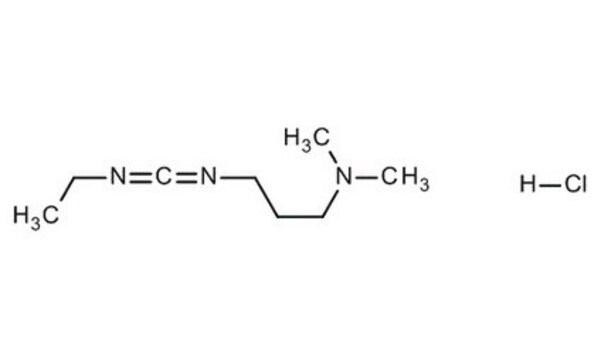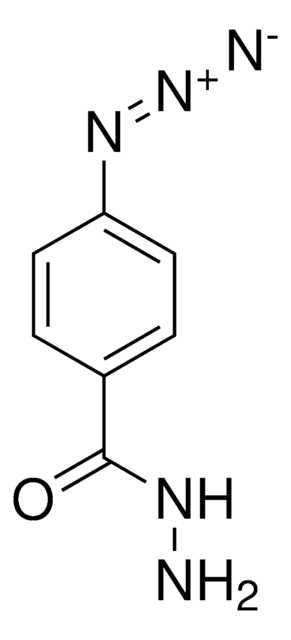39391
N-(3-Dimethylaminopropyl)-N′-ethylcarbodiimide
≥97.0% (T), for peptide synthesis
Synonyme(s) :
N-Ethyl-N′-(3-dimethylaminopropyl)carbodiimide, EDC, WSC
About This Item
Produits recommandés
Nom du produit
N-(3-Dimethylaminopropyl)-N′-ethylcarbodiimide, ≥97.0% (T)
Niveau de qualité
Essai
≥97.0% (T)
Forme
liquid
Capacité de réaction
reaction type: Coupling Reactions
Indice de réfraction
n20/D 1.461
Densité
0.877 g/mL at 20 °C (lit.)
Application(s)
peptide synthesis
Groupe fonctionnel
amine
Température de stockage
−20°C
Chaîne SMILES
CCN=C=NCCCN(C)C
InChI
1S/C8H17N3/c1-4-9-8-10-6-5-7-11(2)3/h4-7H2,1-3H3
Clé InChI
LMDZBCPBFSXMTL-UHFFFAOYSA-N
Description générale
Application
Mention d'avertissement
Danger
Mentions de danger
Conseils de prudence
Classification des risques
Acute Tox. 3 Dermal - Acute Tox. 4 Oral - Aquatic Acute 1 - Aquatic Chronic 1 - Eye Dam. 1 - Skin Corr. 1A - Skin Sens. 1A - STOT RE 2 Oral
Organes cibles
Stomach,large intestine,lymph node
Code de la classe de stockage
6.1A - Combustible acute toxic Cat. 1 and 2 / very toxic hazardous materials
Classe de danger pour l'eau (WGK)
WGK 3
Point d'éclair (°F)
Not applicable
Point d'éclair (°C)
Not applicable
Équipement de protection individuelle
Faceshields, Gloves, Goggles, type ABEK (EN14387) respirator filter
Faites votre choix parmi les versions les plus récentes :
Déjà en possession de ce produit ?
Retrouvez la documentation relative aux produits que vous avez récemment achetés dans la Bibliothèque de documents.
Les clients ont également consulté
Articles
Carbodiimide-mediated peptide coupling remains to the most frequently used technique.
Collagen molecules play a critical role in tissue architecture and strength, and in cell-matrix interactions as insoluble ligands to regulate the diverse phenotypic activities of cells.
Notre équipe de scientifiques dispose d'une expérience dans tous les secteurs de la recherche, notamment en sciences de la vie, science des matériaux, synthèse chimique, chromatographie, analyse et dans de nombreux autres domaines..
Contacter notre Service technique











